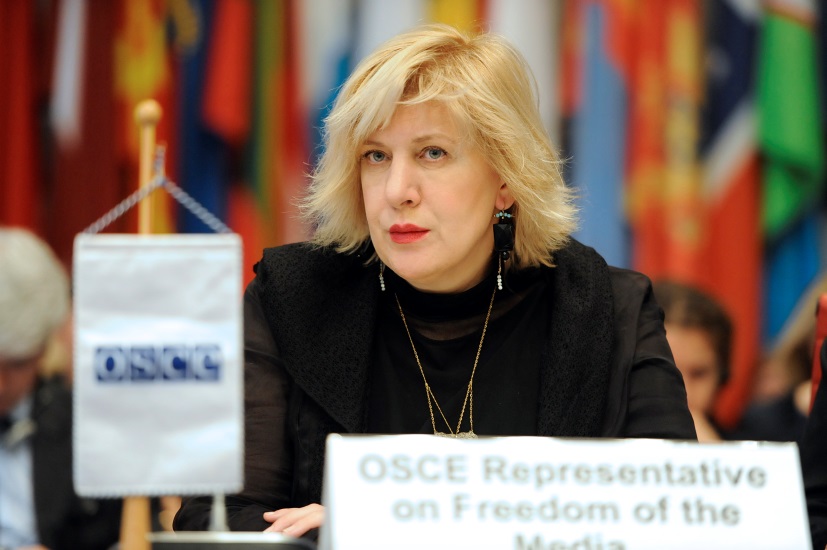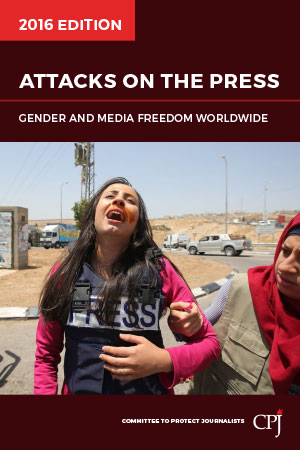A plurality of online voices is good for democracy, yet one group has come under attack in the most gruesome ways. Threats of rape, physical violence and graphic imagery are showing up in the inboxes and on the social media platforms of female journalists across the globe. Though online harassment of journalists is not new, it has become a particular cause for concern and a deterrent to free expression for many female journalists who have made valuable contributions to the news. I have had the privilege to work with many of them.
In February 2015, the Office of the Representative on Freedom of the Media, with the Organization for Security and Co-operation in Europe (OSCE), undertook a qualitative survey to begin taking stock of the prevalence of online harassment of female journalists in participating states. I am the official representative on freedom of the media, and for all of us, the responses we received were a wakeup call, truly shocking in terms of the number and nature of threats most of the women had experienced on a daily basis.
For the sake of brevity, and out of sensitivity to those who have been subjected to such abuse, I will reduce the prevalent message that was being delivered to the journalists this way: “Women who talk too much need to get raped.” The gender component of this harassment is clear, rearing its ugly head in the type of threats and language used, which goes beyond traditional vitriol to employ threats of rape and graphic (often sexual) violence with the aim of silencing women online. Though these journalists were attacked both as journalists and as women, this is not merely a “women’s issue.” Limiting the diversity of voices online hurts everyone, and without the recognition of men and their engagement in combating the attacks, little can be done to stop it.
Women who face this type of harassment have little recourse when it comes to reporting on this type of abuse in a way that will likely produce results, or receive support or legal redress. At best, they are encouraged to ignore the abuse and turn off the computer, and at worst, are blamed for the abuse or for undermining others’ free speech. Obviously, turning off the computer is not an acceptable or realistic solution. While the vitriol may be limited to the virtual world, the threat to women’s safety and reputation is real. In fact, many journalists claim that the very nature of the Internet-which enables complete anonymity and total access to information, including social, personal and financial data-makes it impossible to escape aggressors and multiplies the harmful effects of online harassment. One journalist who responded to our survey wrote, “When I go to the frontline, I choose to go and put myself… in a hostile environment. To feel this psychological stress in my house only because I give my opinion on Twitter or Facebook, it’s unbearable.” It is worth noting that this came from a war correspondent.
Among those surveyed, 95 percent confirmed that the vast majority of the work-related threats and harassment they face takes place online. But the same factors that make it difficult for them to avoid harassment also stymie efforts by law enforcement and government officials to effectively punish those responsible or to prevent the online attacks from occurring. The main problem is that the attacks are amorphous and transitory. There is also a lack of concrete data. For policymakers who want to have a real impact in bolstering female journalists’ safety online, the collection of data, including specific instances of online abuse and the quantitative and qualitative effects on the journalists’ work (both online and offline), would be a key first step.
Also lacking are industry-wide standards on what constitutes hate speech and specific thresholds for restrictions. Journalists need to be able to name and catalogue such abuses, and these standards cannot be set arbitrarily. They will require the input of all stakeholders, including members of civil society, intermediaries, media outlets, international organizations, and journalists.

To begin this process at the Office of the Representative on Freedom of the Media, we used the findings from our survey together with preliminary recommendations that were laid out in our “Communiqué 02/2015 on the Growing Safety Threat to Female Journalists Online” to put together a forum on the issue in September 2015.
Media experts, representatives of Internet intermediary companies, members of the public, and government policymakers from OSCE participating state governments who attended the forum discussed the obstacles that each group of stakeholders face as well as realistic opportunities for countering online harassment. The meeting enabled journalists to talk directly with policymakers about their personal experiences with online harassment, thus framing the debate in the reality of female journalists’ everyday lives, and about the consequences of such abuse, the differences and shared experiences across national borders, and the ways in which they were able to seek support and recourse.
From this discussion, a more comprehensive understanding about the prevalence of this type of abuse took shape. Although the repercussions of online harassment are exacerbated in countries where democratic principles such as freedom of expression already suffer, testimony from journalists at the conference confirmed that the problem occurs throughout the OSCE region, as well as in other parts of the world. Caroline Criado-Perez, a U.K. journalist who has been outspoken about the pervasive harassment she has faced since 2013, shocked the gathering by reading aloud some of the disturbing and graphic threats she has received. Azerbaijani journalist Arzu Geybullayeva told forum participants that she has received several death threats and numerous messages threatening the safety of her and her family. Both women have had their home addresses published online accompanied by threats of rape and physical violence.
Many of the journalists present at the conference spoke about the lack of necessary law enforcement tools and understanding of technology to effectively protect victims. With technology constantly changing, the ways in which journalists are attacked are also evolving, and today include the posting of revenge porn, cyber-mobbing, and denial-of-service attacks. A consensus among those who attended the forum was that digital literacy should be included in comprehensive training for law enforcement officials to ensure that victims get the support they need and that the perpetrators are thwarted-in the best case, before they launch an attack. Law enforcement officials need data on the motivations behind such attacks, ready access to information on legal precedents, and a clear definition of what constitutes a digital hate crime.
The meeting represented the beginning of what I hope will be a long-term focus on this issue at the OSCE and other international organizations. Afterward, my office released a list of specific recommendations for policymakers on how best to ensure that existing legal frameworks are used effectively to support female journalists who are subject to online harassment, including the following:
- Strengthen the capacity of law enforcement agencies to understand international standards on human rights so they can identify real threats to safety and protect individuals in danger, including providing tools and training on technical and legal issues.
- Commission and support the collection and analysis of data related to online abuse and its effects, including creating a database of specific occurrences and follow-up from law enforcement.
- Establish a network of working groups with participating States, international organizations, media, civil society, and Internet intermediaries to develop educational materials, awareness-raising campaigns and create effective structures for dialogue.
- Recognize that threats and other forms of online abuse of female journalists and media actors is a direct attack on freedom of expression and freedom of the media.
These crucial steps would provide law enforcement agencies the tools to better identify these types of crimes and to provide real protection for victims within international legal frameworks.
One of the most important, though less understood, points is that we already have the necessary legal framework to successfully curtail this devastating trend. That framework includes the Universal Declaration of Human Rights, the International Convention on Civil and Political Rights, The U.N. Convention on the Elimination of All Forms of Discrimination against Women, the Beijing Platform for Action, the U.N. Plan of Action on Safety of Journalists and the Issue of Impunity, and a number of U.N. Resolutions including L13 on Internet Free Speech. Together, these measures provide an overarching framework for ensuring that women journalists can freely work. The key is not to introduce new legislation that could have the negative effect of stifling freedom of expression, but to provide the information and resources to effectively use existing legislation to protect journalists’ safety and put an end to gender-based discrimination.
Online abuse endangers media pluralism and democracy as a whole. According to one report, only 24 percent of people working in print, radio and television news are female. If this type of harassment is left unchecked, it could result in self-censorship by female journalists and diminished female perspective online.
One war correspondent who has suffered repeated online harassment, explained in her response to the survey that she had taken time away from her work. “I needed the break,” she wrote. “But it’s made me think if it’s really worth it, to cover Israel and Palestine.” The bottom-line is simple: Policymakers at every level and in every sector must make it a high priority to ensure that journalists of any gender can work freely and without fear of online harassment, which is a direct attack on our fundamental freedoms.
Dunja Mijatović is representative on freedom of the media, a position to which she was appointed in 2010 by the Ministerial Council of the Organization for Security and Co-operation in Europe, which carries a political mandate to protect and promote freedom of expression and freedom of the media in the 57 participating states.
